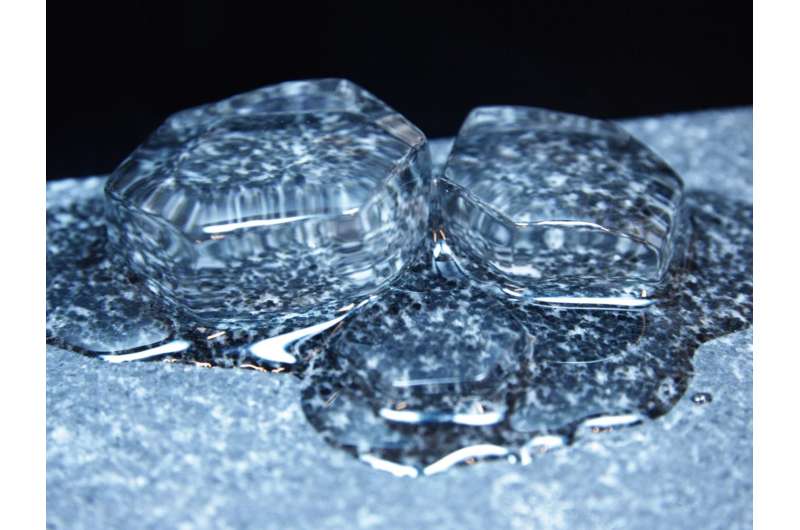Scientists characterize the phase transitions of melting ice layers

150 years ago, physicist Michael Faraday discovered that at the surface of frozen ice, well below 0°C, a thin film of liquid-like water is present. This thin film makes ice slippery and is crucial for the motion of glaciers.
Since Faraday's discovery, scientists have explored the properties of this water-like layer, attempting to determine the temperature at which the surface becomes liquid-like. How does the thickness of the layer depend on temperature? How does the thickness of the layer increase with temperature? Continuously? Stepwise? Experiments to date have generally shown a very thin layer, which continuously grows in thickness up to 45 nm right below the bulk melting point at 0°C. This also illustrates why it has been so challenging to study this layer of liquid-like water on ice—45 nm is about 1/1000th the thickness of human hair and is not discernible by eye.
Scientists of the Max Planck Institute for Polymer Research (MPI-P), in a collaboration with researchers from the Netherlands, the U.S. and Japan, have studied the properties of this quasi-liquid layer on ice at the molecular level using advanced surface-specific spectroscopy and computer simulations. The results are published in the latest edition of the scientific journal Proceedings of the National Academy of Science (PNAS).
The scientists investigated how the thin liquid layer is formed on ice, how it grows with increasing temperature, and if it is distinguishable from normal liquid water. These studies required well-defined ice crystal surfaces. Thus, much effort went into creating ~10 cm single crystals of ice, which could be cut in such a way that the surface structure was measurable. Water molecules in the liquid have a weaker interaction with each other compared to water molecules in ice. Using their interfacial spectroscopy, combined with the controlled heating of the ice crystal, the researchers were able to quantify the change in the interaction between water molecules directly at the interface between ice and air, and determine if the surface was solid or liquid.
The experimental results, combined with the simulations, showed that the first molecular layer at the ice surface was molten at temperatures as low as -38° C (235 K), the lowest temperature the researchers could experimentally investigate. Increasing the temperature to -16° C (257 K), the second layer became liquid. The surface melting of ice is not a continuous process, but occurs in a discontinuous, layer-by-layer fashion.
"A further important question for us was whether one could distinguish between the properties of the quasi-liquid layer and those of normal water," says Mischa Bonn, co-author of the paper and director at the MPI-P. And indeed, the quasi-liquid layer at -4° C (269 K) shows a different spectroscopic response than supercooled water at the same temperature; in the quasi-liquid layer, the water molecules seem to interact more strongly than in liquid water.
The results are not only important for a fundamental understanding of ice, but also for climate science, as many catalytic reactions occur on ice surfaces, and for which the understanding of the ice surface structure is crucial.
More information: PNAS, DOI: 10.1073/pnas.1612893114
Journal information: Proceedings of the National Academy of Sciences
Provided by Max Planck Society





















